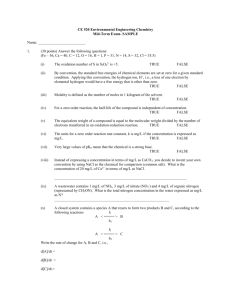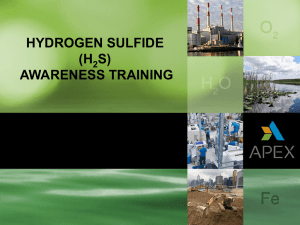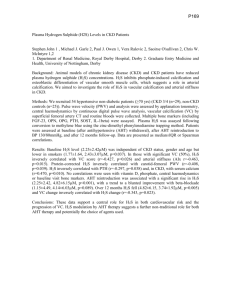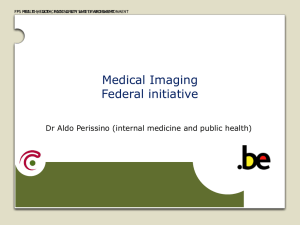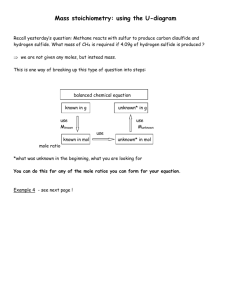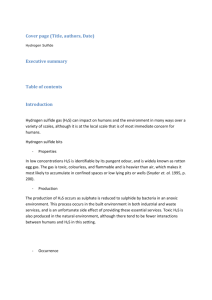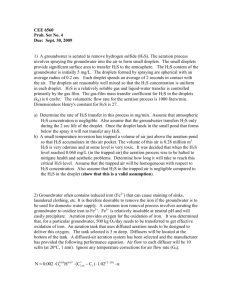Hydrogen Sulfide Gas - Cristine`s final version
advertisement
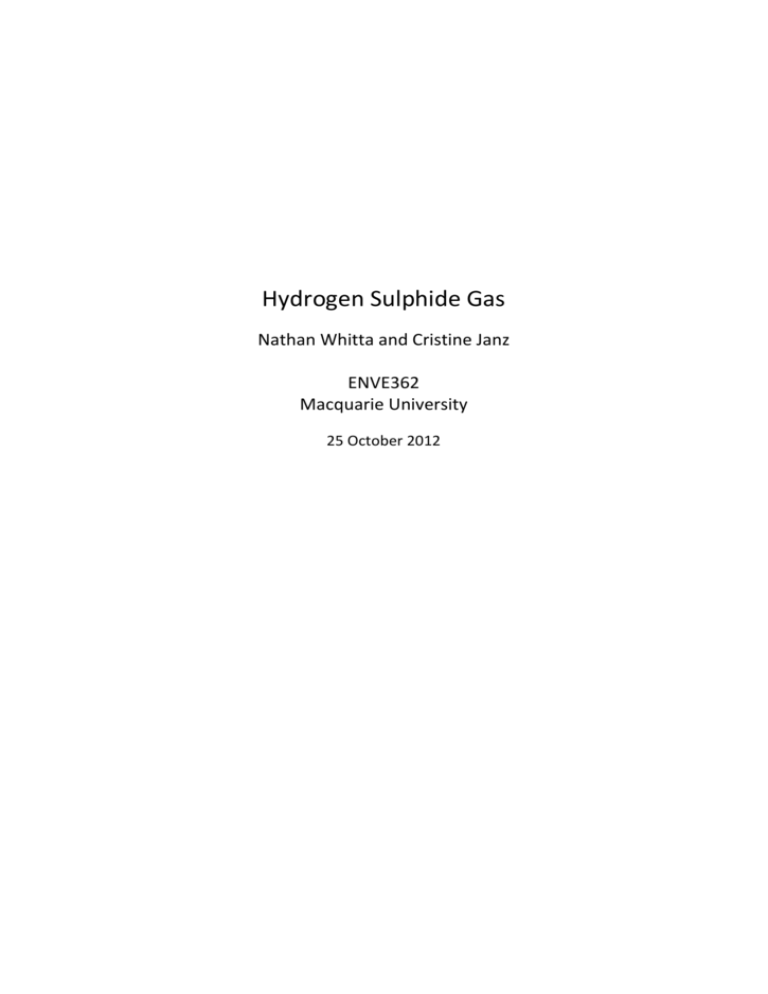
Hydrogen Sulphide Gas Nathan Whitta and Cristine Janz ENVE362 Macquarie University 25 October 2012 Executive summary The intention of this report is to provide an overview of the issues related to the exposure of humans to hydrogen sulphide gas (H2S). H2S is a naturally occurring atmospheric gas, although it is generally found in extremely low concentrations. As concentrations rise above normal background levels the gas becomes a nuisance at low levels, and an extremely toxic hazard as levels rise, particularly above 100 parts per million (ppm). Although H2S can occur at high levels in the natural environment, the hazard for humans primarily comes from H2S produced in providing waste and industrial services for the benefit of society. As these services are essential they cannot be removed, therefore management of the production of the gas and separation of people from the gas itself are the key management techniques. Landfill waste generally produces H2S at lower concentrations, and is generally considered more of a nuisance than a hazard. In this case landfill should be isolated from residential areas where possible, otherwise there are identified techniques for suppressing odour. In sewerage systems the goal is to minimise the production of H2S by providing an oxygenated environment. This is made difficult by the age of much of the sewerage infrastructure in urban environments. Similarly, the industrial sector requires that workers maintain equipment, such as sour gas pipelines, which transport H2S. The corrosive nature of H2S can endanger workers by damaging infrastructure. This in turn provides a contamination hazard for workers in this industrial environment. Where humans must work in potentially contaminated environments they must have detection equipment and breathing apparatus. Contents Executive summary ............................................................................................................................. 2 Introduction ........................................................................................................................................ 2 Issues related to H2S emissions........................................................................................................... 4 Management Approaches................................................................................................................... 5 Summary and Conclusions .................................................................................................................. 7 References .......................................................................................................................................... 7 Introduction Hydrogen sulphide gas (H2S) can impact on humans and the environment in many ways over a variety of scales, although it is at the local scale that is of most immediate concern for humans. Properties In low concentrations H2S is identifiable by its pungent odour, and is widely known as rotten egg gas. The gas is toxic, colourless, and flammable and is heavier than air, which makes it most likely to accumulate in confined spaces or low lying pits or wells (Snyder et. al. 1995, p. 200). Production The production of H2S occurs as sulphate is reduced to sulphide by bacteria in an anoxic environment. This process occurs in the built environment in both industrial and waste services, and is an unfortunate side effect of providing these essential services. Toxic H2S is also produced in the natural environment, although there tend to be fewer interactions between humans and H2S in this setting. Occurrence As a proportion of the atmosphere H2S makes up approximately 0.0001ppm (Li, Hsu & Moore 2009, p. 387). In the natural environment H2S is produced in anoxic environments, such as enclosed stagnant waters or in active geothermal zones. Uses H2S is a by-product of certain industrial and waste disposal processes, and is generally considered to be an unwanted hazard. At the micro-scale, it is produced in the human body and researchers are beginning to understand the benefits it provides to human health in low concentrations (Li, Hsu & Moore 2009). Toxicity At high concentrations H2S becomes a health problem for people (Table 1). Safe Work Australia guidelines limit workers to exposure of 10ppm averaged over the course of an eight hour day, with an absolute limit of 15ppm at any time (Safe Work Australia 2011). Sustained exposure at these low levels can lead to illness and irritation. Health impacts become increasingly more severe as concentrations and exposure rise, with high concentrations at around 1000ppm leading to almost immediate death (Yalamanchili & Smith 2008). Table 1. Effects of H2S on humans (Nogue S et al. 2011) Hydrogen sulphide levels Effects (parts per million) 0.003-0.002 Odour threshold 50 Eye and respiratory irritation 150 Olfactory nerve paralysis 250 Exposure may cause pulmonary oedema 500 Anxiety, headache, ataxia, dizziness, stimulation of respiration, amnesia, unconsciousness 750 Quickly unconscious; death without rescue 1000 Rapid collapse; respiratory paralysis leading to death 5000 Immediate death Waste produced by human society and the manner in which it is stored results in the production of H2S. The odour, corrosive nature and toxicity of H2S poses a number of problems for waste disposal, and these need to be managed for the maintenance of infrastructure and the protection of human health. Several industrial activities also generate H2S as a by-product, ranging from petroleum refineries to tanneries. Such large scale activities can potentially expose workers to high levels of toxic waste, such as this lethal gas. In this paper we discuss the issues associated with H2S emissions by human and industrial waste, as well as efficient management strategies. Issues related to H2S emissions According to the National Pollutant Inventory (NPI) (2010) exposure to levels from 5ppm up to 50ppm begins to cause irritation to the airways and the eyes, at 100ppm it becomes hazardous to human health when exposed to a sustained dose for over an hour, potentially resulting in death. Between 100-150ppm olfactory senses become disabled, meaning the rotten egg smell is no longer present (Yalamanchili & Smith 2008). Above this level even brief exposure becomes life threatening, with time required to cause death reducing as the concentration rises. Knockout occurs immediately with inhalation at around 800ppm and death follows shortly after (Yalamanchili & Smith 2008). The toxicity of H2S at concentrations above ~ 1000ppm makes it a very efficient killer. This characteristic of H2S has led to numerous instances where people intending to commit suicide produce H2S for this purpose (Maebashi et. al. 2011, p. 91). On a larger scale, it has been theorised that H2S has been partly responsible for the mass extinction event that occurred at the end of the Permian period. H2S would have contributed in two ways, first in its role as an ozone depleting gas, and secondly by poisoning the eukaryotic species as the H2S concentration multiplied (Knoll et. al. 2007). Human waste Human activities are responsible for the production of a significant quantity of waste. This waste may occur as refuse, which is generally disposed of and stored as landfill; or alternatively, human faecal waste, which is stored and often treated before being released into the environment. One of the consequences of concentrating this waste is the production of H2S. Landfill generates a number of environmental challenges, one of which is the production of gases resulting from the decomposition of waste material. Amongst the hazardous gases produced by landfill is H2S, which generally occurs in low concentrations (Heaney et. al. 2011, p. 847). The study by Heaney et. al. (2011) suggests that people living in close proximity to landfill sites may suffer negative physical effects from exposure to H2S and other landfill related gases. These are apart from the general negative mental reactions to exposure to unpleasant odorous gases. Although, Heaney et. al. (2011) do not establish whether the negative physical reactions are brought on by psychological responses to the malodour. This experience suggests that although there is the potential for illness from exposure to landfill generated H2S, most negative reactions are resulting from a dislike of the pungent odour. The presence of H2S occurring in response to the treatment of sewage is potentially far more serious than in the landfill scenario. H2S forms during the treatment of waste in an anaerobic environment, where oxygen phobic bacteria reduce sulphate to sulphide, producing the toxic gas (US EPA 1991, p. 5). Wastewater is transported and often stored in enclosed spaces, the resulting limited aeration and the confinement of these spaces both encourage the production of H2S and allow its concentration to multiply (US EPA 1991, p. 5). The corrosive nature of H2S damages sewerage infrastructure and produces leakage, this results in significantly increased maintenance requirements (US EPA 1991). There have been a number of incidents that have resulted in the deaths of workers in the wastewater industry due to H2S exposure. In two instances the toxic exposure occurred within the sewer line, and was worsened by the difficulties in extracting the victim from the confined and toxic location (Yalamanchili & Smith 2008; Christia-Lotter et. al. 2007). These deaths only highlight the difficulty in managing H2S emissions whilst providing essential waste services. Industrial waste Due to the high toxicity of H2S, its release into the atmosphere is potentially life threatening. After carbon monoxide, hydrogen sulphide is the second leading cause of deaths in the workplace related to toxins (Gabbay D et al. 2001). The management of patients contaminated by toxic gases also causes possible danger to the paramedics and emergency staff. Certain professions are especially at risk of H2S exposure, such as pipe fitting, well drilling and servicing, pumping and gas refining. Although fatal accidents are more common in confined spaces where H2S has accumulated over time due to a lack of air exchange, they have also happened in unconfined spaces. In another account, deaths occurred in an unconfined room containing a silo of sludge. The first worker was checking a pump mechanism at the same time that a truck dumped several tons from water purification stations, and lost consciousness. Two other workers tried to help him but also lost consciousness, and all three died. The H2S accumulated inside the silo had spilled out after the dumping of more sludge (Nogue S et al. 2011). Such accounts only reinforce the importance of effective management of H2S emissions. Management Approaches Human waste Waste is an inevitable by-product of human society, therefore dealing with toxic H2S will be an ongoing issue. Management solutions for H2S will involve both separating people from the hazard and attempting to minimise production of the gas. In the case of landfill, ideally communities will be located with enough separation to avoid the odours from these sites. Where communities are impacted by malodour this can be managed with liners, capture of leachate and regular cover with new waste (Heaney et. al. 2011, p. 847). Ultimately whilst H2S is not attributed to significant negative health effects there will be limits to preventative measures. There are a number of approaches for managing the hazard created by the transport and storage of sewage. In existing wastewater infrastructure managing the production of H2S may involve chemical measures or aeration. There are a number of chemical procedures for removing H2S from a sewerage system, these may include Hydrogen Peroxide or Chlorine (US EPA 1991, p. 4-6). In these cases the sulphide component of the H2S is oxidised by the chemicals, removing the gas. The US EPA (1991, p. 4-6) also suggests the use of iron salts to react with the H2S to produce a precipitate that is insoluble. Alternately, measures could be taken to aerate the sewer, removing the anoxic environment that is essential for the H2S to form. Aeration could occur by injecting air or oxygen into the sewer (US EPA 1991 p. 4-6). These methods of reducing the production of H2S would depend on expense and the available infrastructure. Building new infrastructure provides an opportunity to mitigate the impacts of H2S on the sewerage system. Once again, the problem may require a solution that involves adding chemicals to counter H2S production. The sewerage system can be designed taking account of this and be constructed with infrastructure such as chemical addition stations, allowing the most efficient delivery of suppressing chemicals (US EPA 1991, p. 4-7). Alternatively, the design can ensure the sewerage system remains oxygenated. The methods predominantly used include ensuring high velocities in the sewer, providing natural ventilation and creating an environment that encourages turbulence (US EPA 1991, p. 4-10). Whilst this infrastructure may be beneficial in new developments, the heaviest populations are concentrated in existing centres, meaning there is less opportunity to build entirely new sewerage infrastructure. Ultimately, personnel working potentially contaminated environments will rely on gas monitoring equipment and self contained breathing apparatus for personal protection. Industrial waste Different means for H2S control have been used, such as biofilters, biotrickling filters and bioscrubbers (referred to as organic perfusion columns); adsorption using activated carbon, molecular sieves and silica gel; metal oxides; aqueous solutions; and also a combination of activated carbon and oxidation, followed by chemical precipitation (Soreanu G et al. 2010; Oviedo E et al. 2011; McNevi D & Barford J 2000; Sahu R et al. 2001). The efficiency of each technique depends on the gas concentration. The traditional methods for removal are absorption and adsorption, but the high cost of equipment, toxic chemical usage and secondary contaminations pose problems (Chang & Shin 1993, cited in Oh K et al. 1999). Currently, chemicals are added to the water to eliminate sulphide by chemical precipitation - using iron or other metal salts - or oxidation - using hydrogen peroxide, oxygen or chlorine (Oviedo E et al. 2011). In the last decade, extensive research has been conducted in applied biotechnology for the treatment of gas fluxes, and biological treatments were recognised as environmentally-friendly and cost-effective alternatives to traditional technologies (Ahn 1993, cited in Oh K et al. 1999). Removal using microbes is generally divided into aerobic and anaerobic. Aerobic microbes used to oxidise H2S are Thiobacillus, Pseudomonas, Beggiatoa and Thiotrix (Tanji et al. 1989, cited in Oh K et al. 1999), while phototrophic bacteria such as Chlorobium and Chromatium are used in anaerobic processes to convert H2S to elemental sulphur and sulphate, depending on the intensity of light (Kusai and Yamanaka 1973, cited in Oh K et al. 1999). A different control strategy also using biotechnology is preventing the formation of sulphides, either by the addition of biocides to inhibit the activity of sulphate-reducing bacteria (SRB) or by the addition of sodium hydroxide or calcium hydroxide to elevate the pH to inactivate SRB activity (Oviedo E et al. 2011). Another promising option is the use of red mud, a mining waste material. This caustic by-product of the alumina industry currently has no economical value and can be used at ambient conditions. In addition to effectively removing H2S from industrial emission and significantly reducing industrial air pollution, this method also has the benefits of solving the problem of another industry’s waste with no additional manufacturing cost (Sahu R et al. 2001). In addition to emission control methods, H2S alarms are used in industrial facilities. Casualties must be removed from the area into fresh air, and rescue staff must wear breathing apparatus. Supplemental oxygen or hyberbaric oxygen should be administered to the victim (Vale A 2011). Summary and Conclusions Exposure to hydrogen sulphide pose many problems due to its high toxicity. Whether a by-product of human or industrial waste, H2S emissions must be controlled to avoid fatalities. Management strategies such as chemical procedures to remove the gas, aeration to avoid anoxic environments and improving the design of sewerage system infrastructure have been successfully used to deal with emissions from human waste. In the industrial setting, different biotechnologies are replacing more traditional methods such as absorption and adsorption, the addition of chemicals to oxidate and precipitate. The use of red mud offers the most advantages, since it uses the waste of alumina mining. The effective control of hydrogen sulphide emissions must be ensured to decrease air pollution and avoid fatal accidents. References Christia-Lotter, A., Bartoli, C., Piercechi-Marti, M., Demory, D., Pelissier-Alicot, A., Sanvoisin, A. & Leonetti, G. 2007, ‘Fatal occupational inhalation of hydrogen sulfide’, Forensic Science International, vol. 169, pp. 206-209. Gabbay, D., Roos, F., Perrone, J. 2001, ‘Twenty-foot fall averts fatality from massive hydrogen sulphide exposure’, The Journal of Emergency Medicine, Vol. 20, No. 2, pp. 141-144. Heaney, C., Wing, S., Campbell, R., Caldwell, D., Hopkins, B., Richardson, D. & Yeatts, K. 2011, ‘Relation between malodour, ambient hydrogen sulfide, and health in a community bordering a landfill, Environmental Research, vol. 111, pp. 847-852. Li, L., Hsu, A. & Moore, P. 2009, ‘Actions and interactions of nitric oxide, carbon monoxide and hydrogen sulphide in the cardiovascular system and in inflammation – a tale of three gases!’, Pharmacology & Therapeutics, vol. 123, pp. 386-400. Maebashi, K., Iwadate, K., Sakai, K., Takatsu, A., Fukui, K., Aoyagi, M., Ochiai, E. & Nagai, T. 2011, ‘Toxicological analysis of 17 autopsy cases of hydrogen sulfide poisoning resulting from the inhalation of intentionally generated hydrogen sulfide gas’, Forensic Science International, vol. 207, pp. 91-95. McNevi, D., Barford, J. 2000, ‘Biofiltration as an odour abatement strategy’, Biochemical Engineering Journal, Vol. 5, pp. 231-242. National Pollution Inventory 2010, Department of Sustainability, Environment, Water, Population and Communities, Canberra, ACT, Retrieved 20 Oct 12 from http://www.npi.gov.au/substances/hydrogen-sulfide/health.html Nogue, S., Pou, R., Fernandez, J., Sanz-Gallen, P. 2011, ‘Fatal hydrogen sulphide poisoning in unconfined spaces’, Occupational Medicine, Vol. 61, pp. 212-214. Oh, K., Kim, D., Lee, I-H. 1999, ‘Development of effective hydrogen sulphide removing equipment using Thiobacillus sp.IW’, Environmental Pollution, Vol. 99, pp. 87-92. Oviedo, E., Johnson, D., Shipley, H. 2011, ‘Evaluation of hydrogen sulphide concentration and control in a sewer system’, Environmental Technology, Vol. 33, No. 10, pp. 1207-1215. Safe Work Australia 2011, Workplace exposure standards for airborne contaminants, Retrieved 21 Oct 12 from http://www.safeworkaustralia.gov.au/sites/swa/AboutSafeWorkAustralia/WhatWeDo/Publi cations/Documents/639/Workplace_Exposure_Standards_for_Airborne_Contaminants.docx - 22/12/2011 Sahu, R., Pate, R., Ray, B. 2011, ‘Removal of hydrogen sulphide using red mud at ambient conditions’, Fuel Processing Technology, Vol. 92, pp. 1587-1592. Snyder, J., Safir, E., Summerville, G. & Middleberg, R. 1995, ‘Occupational fatality and persistent neurological sequelae after mass exposure to hydrogen sulfide’, American Journal of Emergency Medicine, vol. 13, no. 2, pp. 199-203. Soreanu, G., Falletta, P., Beland, M., Edmonson, K., Ventresca, B., Seto, P. 2010, ‘Empirical modelling and dual-performance optimisation of a hydrogen sulphide removal process for biogas treatment’, Bioresource Technology, Vol. 101, pp. 9387-9390. Transportation Safety Board of Canada 2009, Pipeline Investigation Report P09H0006, Retrieved 12 Oct 12 from http://www.tsb.gc.ca/eng/rapportsreports/pipeline/2009/p09h0006/p09h0006.asp United States Environmental Protection Agency, 1991, Hydrogen Sulfide corrosion in wastewater collection and treatment systems, Retrieved 10 Oct 12 from http://www.epa.gov/nscep/index.html Vale, A. 2011, ‘Hydrogen Sulphide’, Medicine, Vol. 40, p. 3. Yalamanchili, C. & Smith, M. 2008, ‘Acute hydrogen sulfide toxicity due to sewer gas exposure’, American Journal of Emergency Medicine, vol. 26, pp. 518.e5-518.e7.
